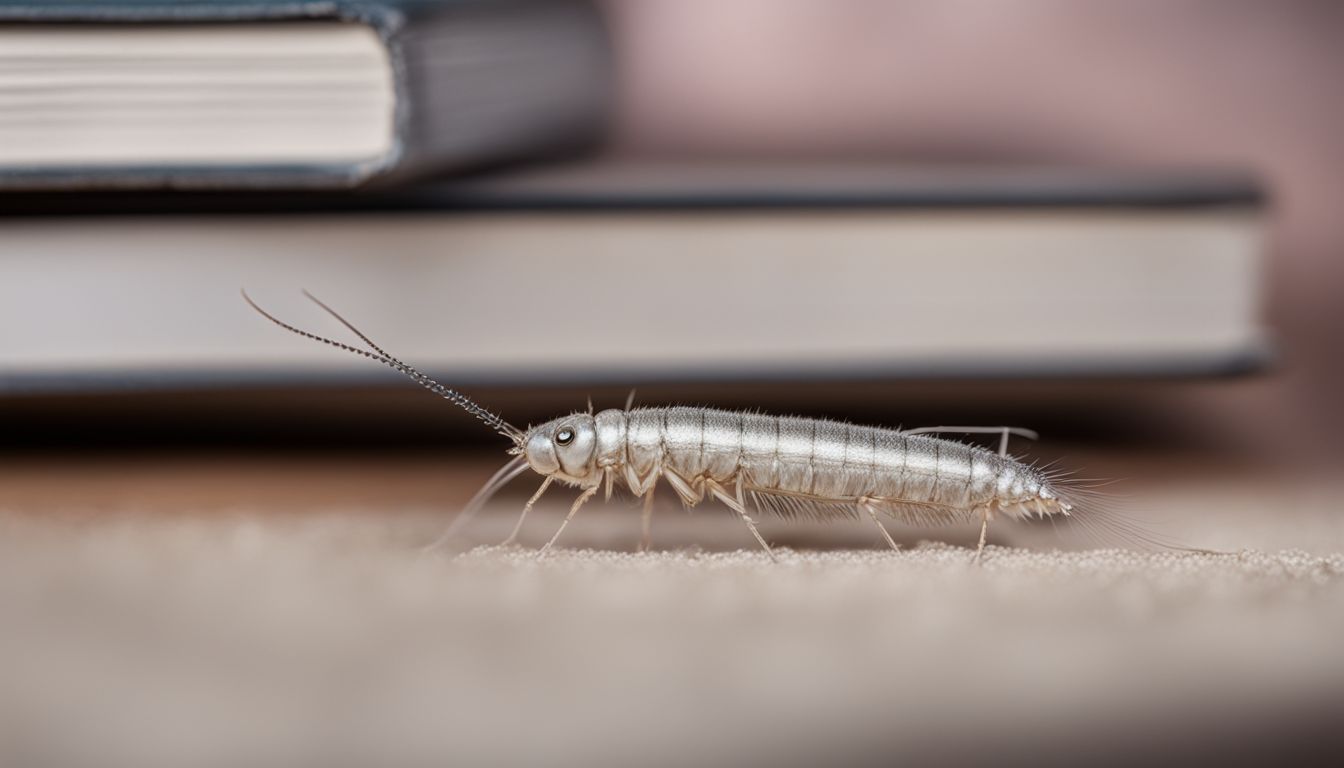“This post contains affiliate links. As an Amazon Associate, I earn from qualifying purchases”
Have you ever spotted a tiny, silvery insect darting across your bathroom floor and wondered if it’s gearing up for an Olympic sprint? You’re probably dealing with silverfish, those mysterious little critters that seem to appear out of nowhere.
Common myths about these pests abound—like the idea they move at blinding speed or have the power to leap tall buildings in a single bound. In reality, while silverfish are indeed quick movers, their pace isn’t quite worthy of superhero status.
Here’s one fact that might surprise you: Silverfish can’t jump or fly at all! Despite what some tall tales suggest, they navigate their world entirely on foot—well, six feet to be exact.
Curious about how else we’ve been getting our facts wrong about these shiny insects? Our blog is here to shine a light on the truth behind silverfish movement. By separating fact from fiction, we’ll help clear up any misconceptions so you can manage them effectively without unease.
Keep reading; there’s plenty more myth-busting ahead!
Understanding Silverfish

2. Understanding Silverfish: Let’s dive into the secret life of these nocturnal insects, known as Lepisma saccharina in scientific circles—peering into their shadowy world of basements and bookshelves to truly get a sense of what makes them tick..
or rather, scuttle.
Identification and habits
Silverfish are tiny bugs with no wings and a shape like a teardrop. They carry long feelers and love the night time, often hiding in moist places like under your sink or in the basement.
These critters eat all kinds of things—wallpaper paste, clothes, and even other bugs! Since they’re always on the move in quick, zigzag patterns, they can surprise you when you flick on the lights during their midnight snack runs.
To keep these pests away from your home, make sure areas stay dry by using dehumidifiers. Clean up crumbs and spills to cut off their food supply. Seal gaps where they might creep in with caulk so that kitchens and bathrooms stay bug-free zones.
Remembering these tips will help discourage silverfish from taking up residence where you live.
Separating Fact from Fiction

In the heart of our discussion, we’ll tackle common misconceptions head-on and reveal some surprising truths about silverfish—stay tuned to demystify these agile critters.
Myth: Silverfish are a form of fish
Silverfish got their name because they’re shiny and wiggle like fish when they move. But let’s get this straight – silverfish are not fish at all. They belong to a group of insects, specifically the order Zygentoma, and are entirely wingless.
So, no gills or fins here! These critters have been scurrying around for over 400 million years, way before dinosaurs stomped about.
Even though they dart quickly like tiny fish might swim across a stream, calling them “fish” is just misleading. If you find them in your house, don’t expect to see them swimming in your sink.
Silverfish love damp areas but you’ll more likely spot them on land, darting out from books or hiding in dark corners rather than taking a dip. Keep an eye out because these little pests can be quite sneaky and hard to catch!
Myth: Silverfish move very slowly
Clearly, these critters are not swimming creatures as some might think. Moving on from that, many believe silverfish don’t hustle much either. This isn’t true—they can zip around quite fast! If a silverfish senses danger or spots something yummy to eat, it races off at a surprising speed.
Their quick dashes often go unnoticed because they prefer the dark and are mostly active at night.
Their wriggly way of moving can trick your eyes into thinking they’re just leisurely sliding along. But make no mistake—if you tried catching one, you’d see how speedy they really are! For those dealing with them in their homes, knowing this can help in pest management efforts.
Quick actions such as sealing food storage areas and using preventative measures like diatomaceous earth may keep these nuisance pests at bay before they scuttle out of sight.
Misconception: Silverfish can communicate with humans
Silverfish are little, wingless insects that like to hide in damp areas. Some people think silverfish can talk or send signals to humans. This is not true. These bugs do not have the power to understand our words or respond back with sounds or movements.
They live their lives without chatting with us, no matter how much we might want to ask them why they’re sneaking around our homes! Pest control experts know this well – they deal with these critters using science and tools, not conversation.
If you see a silverfish in your home, it’s busy looking for food and water; it’s not trying to tell you anything.
Debunking the myth that silverfish hate lavender
Now, let’s clear up another common belief. Many people think that lavender will keep silverfish away. They believe these pests can’t stand the scent of this aromatic herb. However, there is no real proof to support this idea.
Studies have not shown that lavender oil or plants stop silverfish from coming into your home.
So if you’re trying to use lavender as a way to get rid of these bugs, it might not work as well as you expect. It’s important to look for other ways to handle a silverfish problem.
Look into using methods like cleaning up food crumbs, fixing damp areas, and sealing cracks where they can enter your space. These steps are more likely to help keep silverfish away than relying on the smell of lavender alone.
Conclusion
So, we’ve looked into the truth about silverfish. They’re not fish and they don’t zip around like lightning. Remember, these little critters can’t talk to us or jump high. Instead, they just love dark and moist spots where they quietly munch on books and papers.
Understanding them better helps keep our homes safe without fear.
FAQs
1. Can silverfish, also known as fish moths, move like fish?
Nope, they can’t swim. Silverfish get their name because of how they move side to side – it kind of looks like a fish swimming but on land.
2. Are silverfish clean or do they bring germs?
They love damp and dusty spots but don’t spread diseases like ticks or mosquitoes. Still, good hygiene helps keep them away from your home!
3. Do I need an exterminator or can I handle silverfish myself?
You might fix the problem with boric acid or other preventive measures… But if you’re seeing lots of them? Time to call in the pros for some integrated pest management (IPM).
4. What about my pets? Are these critters harmful to cats and dogs?
Silverfish aren’t predatory – so no worries there! They’d rather munch on sugars than bother your furry friends.
5. If I see one silverfish, does that mean there are more hiding in crawl spaces?
Could be – these guys tend to hang out where it’s dark and moist. Check those places often!
6. Is it true that pests like fleas and silverfish can mark their territories just like dogs do?
Not quite the same way! Dogs have a whole range of ways (like body language) to show who’s boss, while insects rely more on scents left behind as signals.